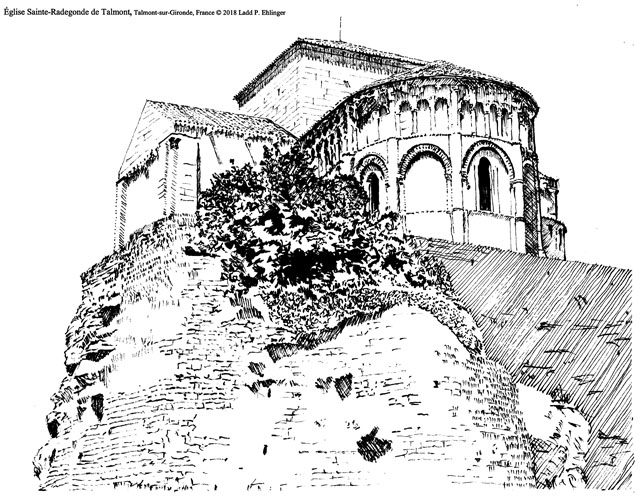
Projects Newsletters Personnel Contact

Église Sainte-Radegonde de Talmont, Talmont-sur-Gironde, France (St. Radegonde Church of Talmont on the Gironde) is this issue’s limited edition print of a sketch by Ladd P. Ehlinger, AIA. The view is looking up from the level of the marshes of the estuary of the Gironde river at the chevet where the choir and the altar are on the east end of the church. The west end of the church no longer exists, having been destroyed along with the portion of the stone promontory upon which the church sat, in a storm over a hundred years ago. Most of the nave (main body of the church), the longest leg of the Latin cross plan of the church, fell into the sea. Only one bay of the original nave remains. The base of the church has since been repaired and strengthened by the new stone foundations adding to and repairing the native stone, to function as a bulwark against future storms. The nave was shortened to one bay to reflect the reality of no footprint to restore, and the current entrance is from the north through the north arm of the transept or crossing in the plan of the church.
St. Radegonde is a classic Romanesque style church. The design and construction was originally begun in the mid XI Century, about 1094. Romanesque buildings are characterized by Roman style semi-circular arches that have a thick band of vousoirs (the wedge shaped segments of the arch) with decorative features and sculptures above and below, yet with small windows, as there was caution by the builders not to exceed the limitations of the stone in the openings. The spans on the interior are stone barrel vaulted, with a dome on pendentives (three dimensional wedges in the corners of the square support of the dome to transition to the circular dome). In the sketch, this is only reflected in the large stone box that towers above the chevet and the transept. The roof construction is composed of heavy timber on top of the vaulting, topped with the clay tile roofing. In addition, there are numerous sculptures throughout, and those of the portal entrances depict biblical stories as a means of teaching the bible to an illiterate congregation. There are two staircases leading to a crypt with two levels, the lower of which is an ossuary that is surmounted by a funerary chapel.
Sainte-Radegonde is the French spelling for the Merovingian Queen, Radegunda or Radegundis. The Merovingian period began immediately after the fall of Rome in the 5th and 6th Centuries, and was then succeeded by the Carolingian Kings (Charles the Great). The Merovingians occupied all of present day France, the Netherlands, Belgium, and most of Germany. Radegunda was a Princess of Thuringia, a part of Alemania between the Nektar River and the upper Danube. She was captured by King Chlotar I in 531 in an expedition against the Thungians, and he carried her off to Poitiers, where he married her. Chlotar I complained about her piety and lack of interest in the marriage since she was always ministering to the poor and sick, saying that he may as well have married a nun.
Indeed, Radegunda petitioned the Bishop Medard of Noyon to allow her to become a nun, and the Bishop finally relented, agreeing to her leaving the marriage and doing just that. She subsequently founded the Order of the Holy Cross of Poitiers. Radegunda’s piety and holiness so impressed a great many people, that some followed her example and became nuns and priests. An example was the Roman Venantius Fortunatus, who became a priest, and later Bishop of Poitiers. Sainte-Radegonde died August 13, 587, which date is now her feast day in the Catholic Church.